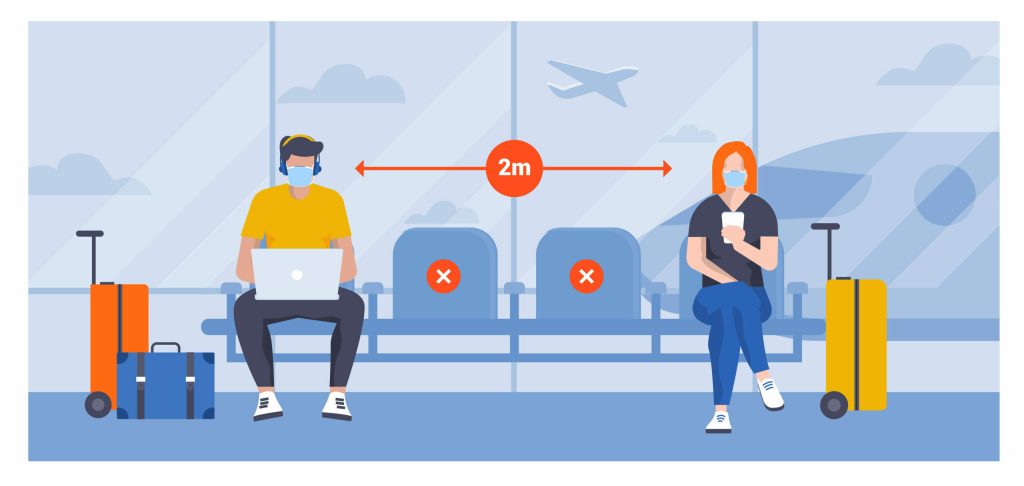COVID-19 Safe Workplace Training Supplement
Provincial Guidance Supplement
Updated: November 23, 2021
COVID-19 guidance rapidly evolves in response to virus variants and new scientific evidence. Please review this Federal Guidance Supplement to our COVID-19 Safe Workplace Training for the latest CDC and Public Health Agency of Canada guidance related to the topics discussed in the course. Then, return to the State Resources.
Everyone must follow all safe work practices required by local law or workplace policy
COVID-19 Vaccines
This information supplements our COVID-19 Safe Workplace Training on vaccination.

Vaccination is key in protecting everyone in the workplace from COVID-19. COVID-19 vaccines are safe and effective at preventing severe illness, hospitalizations, and death. The CDC advises everyone to get a COVID-19 vaccine as soon as they can.
The CDC also recommends that everyone ages 18 years and older who are fully vaccinated get a booster shot. The timing for a booster shot depends on the type of vaccine received for your primary COVID-19 vaccination series.
You can find the latest guidance on COVID-19 vaccines at the CDC website.
When You Are Fully Vaccinated
This information supplements our COVID-19 Safe Workplace Training for fully vaccinated workers.
If you are fully vaccinated, the CDC says that you can safely resume many of the activities that you did prior to the pandemic.
Because fully vaccinated people who become infected with the Delta variant can spread it to others, the CDC and Public Health Agency of Canada recommend that fully vaccinated people wear a mask in indoor public spaces in areas with substantial or high transmission rates. Mask use in these circumstances can maximize protection and prevent spreading the Delta variant to others.
Additionally, fully vaccinated people might choose to wear a mask regardless of the level of transmission, particularly if they are immunocompromised or at increased risk for severe disease from COVID-19, or if they have someone in their household who is immunocompromised, at increased risk of severe disease or not fully vaccinated.
Fully vaccinated means two weeks after a person has received the final dose of a COVID-19 vaccine authorized or approved by the FDA.
Everyone must follow all safe work practices required by law or workplace policy, regardless of vaccination status.
Unvaccinated and At-Risk Workers
This information supplements our COVID-19 Safe Workplace Training on recommended safe work practices for unvaccinated and at-risk workers.
Unvaccinated Workers
If you are not fully vaccinated, you should follow a combination of safe work practices to reduce the risk of getting and spreading COVID-19.
At-Risk Workers
Even if you are fully vaccinated, you may not be protected from COVID-19 if you have a condition or are taking medications that weaken your immune system. The CDC advises that you take all the precautions recommended for people who are fully vaccinated until advised otherwise by your healthcare provider.
Protections for Unvaccinated and At-Risk Workers
If you are not fully vaccinated, or otherwise at-risk, the CDC and Public Health Agency of Canada recommend taking the following steps to protect yourself and others from all the ways COVID-19 can spread:
Get a COVID-19 vaccine as soon as you can if you have not already done so. Once you are fully vaccinated, you may be able to start doing some things you had stopped doing because of the pandemic.
Wear a mask that covers your nose and mouth in indoor public spaces to help protect yourself and others.
In general, you do not need to wear a mask in outdoor settings.
However, in areas with high numbers of COVID-19 cases, you should consider wearing a mask in crowded outdoor settings and for activities with close contact with others who are not fully vaccinated.
Stay at least 6 feet apart from others who don’t live with you, particularly if you are at increased risk for severe illness.
Avoid crowds and poorly ventilated indoor spaces and improve ventilation. Being in crowds like restaurants, bars, fitness centers, or movie theatres puts you at higher risk for COVID-19. Avoid indoor spaces that do not offer fresh air from the outdoors as much as possible.
Wash your hands often with soap and water. Use hand sanitizer if soap and water aren’t available.
You can find the latest guidance on what unvaccinated and at-risk workers can do to protect themselves and others from the CDC and Public Health Agency of Canada.
Everyone must follow all safe work practices required by law or workplace policy, regardless of vaccination status.
Face Masks Required for U.S. Travel
This information supplements our COVID-19 Safe Workplace Training on masks.
Regardless of vaccination status, everyone must wear a mask indoors when traveling into and within U.S. airports and on board commercial aircraft, over-the-road buses, commuter bus and rail systems, and any other form of public transportation, through January 18, 2022.
Prior to travel, you should should check TSA and CDC websites for the most recent guidelines and requirements.

Face Mask Fit & Types
This information supplements our COVID-19 Safe Workplace Training on face mask fits and types.
The CDC continues to study how masks help to slow the spread of COVID-19. CDC mask guidance on gaiters, face shields, and goggles, and wearing a mask with glasses or a beard are outlined below.
Gaiters & Face Shields
The CDC does not recommend the use of face shields. Evaluation of face shields is ongoing, but effectiveness is unknown at this time.
If you wear a gaiter, wear one with two layers or fold it to make two layers.
Wearing a Mask with a Beard
Certain types of facial hair, like beards, can make mask fitting difficult. Masks that fit well protect you better. To have a better fit, people with beards can shave their beards or trim their beards close to the face.
For people with beards that are not trimmed close to the face, masks may fit loosely around the beard. However, people with beards should still wear a mask.
Ways to improve mask fit:
-
Use a mask fitter or brace
-
Wear one disposable mask underneath a cloth mask that has multiple layers of fabric. The second mask should push the edges of the inner mask against the face and beard.
How to Store & Wash Masks
This information supplements our COVID-19 Safe Workplace Training on how to store and wash masks.
Storing Your Mask
Clean Masks
You can store your mask temporarily to reuse later. Remove your mask correctly and wash your hands after touching a used mask. Keep it in a dry, breathable bag (like a paper or mesh fabric bag) to keep it clean between uses. When reusing your mask, keep the same side facing out.
If you are taking off your mask to eat or drink outside of your home, you can place it somewhere safe to keep it clean, such as your pocket, purse, or paper bag.
Make sure to wash or sanitize your hands after removing your mask. After eating, put the mask back on with the same side facing out. Be sure to wash or sanitize your hands again after putting your mask back on.
Wet or Dirty Mask
You should replace a wet or soiled mask with a clean mask. A wet mask is less effective and can make it hard to breathe.
Store a wet reusable mask in a plastic bag until you are able to put can put it in the laundry. To keep a reusable mask clean between uses, you can temporarily store it in a dry paper or mesh fabric bag. When reusing the mask, keep the same side facing out. Be sure to remove and put on the mask correctly.
Washing Your Mask
Disposable masks must be thrown away after each use. Damaged reusable masks should also be discarded.
Reusable masks should be washed daily – ideally after each work shift – and wet and dirty masks as soon as possible to prevent mold. To wash your mask effectively, follow these steps:
Include your mask with your regular laundry.
Use regular laundry detergent.
Use the appropriate settings according to the fabric label.
Dry your mask completely in a warm or hot dryer.
You can find the latest guidance on how to store and wash masks at the CDC website.

Ventilation
This information supplements our COVID-19 Safe Workplace Training.
Ensuring adequate ventilation throughout the work environment can help limit the spread of COVID-19.
COVID-19 viral particles spread more readily indoors because the concentration of viral particles is often higher than outdoors. When possible, introducing outdoor air can help improve ventilation, such as opening windows and using fans.
If you see that a vent is clogged, dirty, or blocked by furniture or equipment, report it immediately to Human Resources or the building manager.
Local guidance evolves as scientists learn more about the COVID-19 virus.
You can find the latest guidance on COVID-19 ventilation in the workplace and ventilation in buildings from the CDC and Public Health Agency of Canada.
Hand Sanitizer
This information supplements our COVID-19 Safe Workplace Training on hand sanitizer.
Hand sanitizer is not as effective as washing your hands at removing all types of germs or when your hands are visibly dirty or greasy. If your hands are visibly dirty or greasy, you should always wash your hands with soap and water.
If soap and water are not available, and your hands are not visibly dirty or greasy, you can use a hand sanitizer with at least 60% alcohol, and then wash your hands with soap and water as soon as you can.
Follow the steps described in the course to use hand sanitizer effectively.
Cleaning & Disinfection
This information supplements our COVID-19 Safe Workplace Training on cleaning and disinfection.
Cleaning and disinfecting can also reduce the risk of infection in the workplace. Cleaning with products containing soap or detergent reduces germs on surfaces. Disinfecting kills any remaining germs.
If you are involved in cleaning or disinfecting your work area or any other part of the workplace, you should use cleaners and disinfectants safely and effectively.
Safe Use of Product
Always read and follow the product label for instructions on safe use.
The product label will list any necessary safety precautions, such as PPE (e.g., gloves, glasses, or goggles), ventilation (e.g., open windows), and other precautions.
Wash your hands after cleaning or disinfecting and after removing gloves or other protection.
Special considerations should be made for people with asthma. Learn more about reducing your chance of an asthma attack while cleaning and disinfecting.
Clean & Disinfect Effectively
Always read and follow the product label for effective use, including concentration, application, and contact time.
Daily cleaning with products containing soap or detergent is usually sufficient to remove viruses that may be on surfaces.
When disinfection is needed, use products that are effective against COVID-19 from the EPA’s List N. If those products are not available, bleach solutions can be used if appropriate for the surface.
Electronics
Consider placing a wipeable cover on electronics for easier cleaning and disinfecting.
Follow the manufacturer’s instructions and recommendations for cleaning the electronic device.
For electronic surfaces that need to be disinfected, use a product on EPA’s List N that meets the manufacturer’s recommendations. Many products for electronics contain alcohol because it dries quickly.
Soft Surfaces
For soft surfaces, such as carpets, rugs, and drapes, clean the surface using a product containing soap, detergent, or other cleaner appropriate for these items.
Launder clothing, towels, linens, and soft surfaces (if possible), and other similar items. Use the warmest appropriate water setting and dry items completely.
If you need to disinfect, use a product approved for soft surfaces on EPA’s List N.
Vacuum as usual.
Health Monitoring
This information supplements our COVID-19 Safe Workplace Training on health monitoring.
Everyone should monitor their health daily for COVID-19 symptoms, regardless of vaccination status.
Do not come to work if you have any symptoms or test positive for COVID-19. Follow the applicable absence reporting procedures at your workplace.
Notify your supervisor immediately if:
If you are well when you arrive to work but develop COVID-19 symptoms during the workday.
If you were recently exposed to someone with suspected or confirmed COVID-19.
Contact your healthcare provider or use the CDC Coronavirus Self-checker to help make decisions on when to seek testing and medical care.
Workplace Safety Feedback or Concerns
Workers have the right to a safe workplace free from known health and safety hazards. Please contact Human Resources or the COVID-19 contact person for your worksite if you have any COVID-19 workplace safety-related concerns, suggestions, or feedback, or if you have questions about any of the information covered in this training.
Retaliation is strictly prohibited against workers who raise concerns about unsafe working conditions or report COVID-19 infection or exposure.
Workplace & Job-duty Specific Information
Safe work practices may differ depending on job duties and work setting.
If necessary, you will be provided additional education on workplace or job-duty-specific information and training on COVID-19 safe work practices. Managers will also receive instruction on how to implement COVID-19 policies.
Workers who are required to wear personal protective equipment – PPE – will be provided training on proper use and care.
Contact Human Resources or the COVID-19 contact person for your worksite for more information.
Everyone must follow all safe work practices required by law or workplace policy.